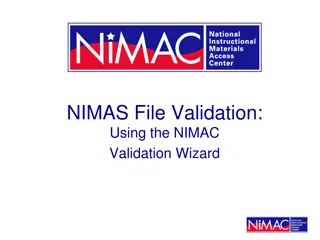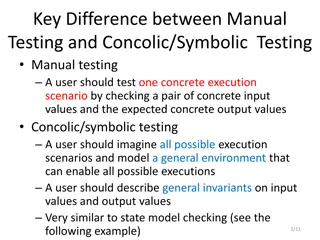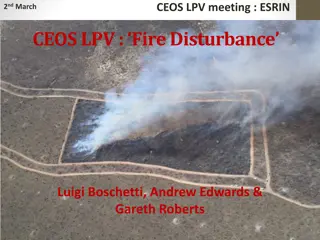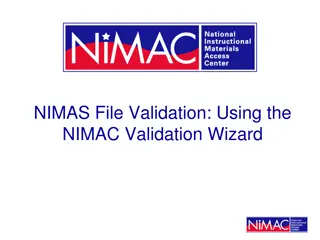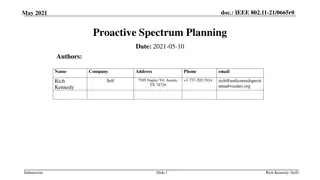Concolic Execution: Spectrum of Program Validation Methods
Concolic execution, formal methods, and program validation methods are explored through a spectrum involving path explosion, environment modeling, solver limitations, and concolic execution steps. Various techniques and challenges in testing complex programs effectively are illustrated with explanations and visual aids.
Download Presentation

Please find below an Image/Link to download the presentation.
The content on the website is provided AS IS for your information and personal use only. It may not be sold, licensed, or shared on other websites without obtaining consent from the author.If you encounter any issues during the download, it is possible that the publisher has removed the file from their server.
You are allowed to download the files provided on this website for personal or commercial use, subject to the condition that they are used lawfully. All files are the property of their respective owners.
The content on the website is provided AS IS for your information and personal use only. It may not be sold, licensed, or shared on other websites without obtaining consent from the author.
E N D
Presentation Transcript
CSE 331 Software Design & Implementation Andrew Gies Winter 2021 HW9, Spark Java, Fetch UW CSE 331 Winter 2021 1
Administrivia HW8 due this week (Thur. 3/4 @ 11:00pm) Section this week is Question Time No planned material come hang out and ask questions HW 9 Due a week later (Thur. 3/11 @ 11:00pm) Spec released later today. Plan ahead - this assignment can take a little longer than others. Get creative! Lots of cool opportunities. Any questions? UW CSE 331 Winter 2021 2
Agenda HW9 Overview Anonymous Inner Classes Common Java idiom can make code easier to write. Come in handy when writing the Java server. JSON Brief overview Helps share data between Java and JS. Fetch How your JS sends requests to the Java server. Spark Java How to turn your hw-pathfinder code into a Java server. UW CSE 331 Winter 2021 3
Homework 9 Overview Creating a new web GUI using React Display a map and draw paths between two points on the map. Works just like your React app in HW8 but you get to design it! Send requests to your Java server (new) to request building and path info. Creating a Java server as part of your previous HW5-7 code Receives requests from the React app to calculate paths/send data. Not much code to write here thanks to MVC. Reuse your CampusMap class from HW7. UW CSE 331 Winter 2021 4
The Campus Paths Stack CampusPaths Dev Server/Compiler localhost:3000 Started with npm start Google Chrome Can I have the webpage? http://localhost:3000 Your TypeScript Code Here s some HTML and JS Your React Application Spark Java Server* localhost:4567 Started with runSpark gradle task <canvas> SparkServer Can I get some data? <button> CampusMap Other Components Here s some JSON with your data. Other pathfinder Code *Note: This is not Apache Spark UW CSE 331 Winter 2021 5
Any Questions? Done: HW9 Basic Overview Up Next: Anonymous Inner Classes JSON Fetch Spark Java UW CSE 331 Winter 2021 6
Anonymous Inner Classes Helps put code closer to where it s used. Makes sense when you aren t re-using classes. The Example: sorting Strings by length instead of alphabetically. We need to make a Comparator but how best to organize our code? Start with what we re used to, then refine. UW CSE 331 Winter 2021 7
Anonymous Inner Classes (Attempt 1) public class StringSorter { public static void main(String[] args) { String[] strings = new String[]{"CSE331", "UW", "React", "Java"}; Arrays.sort(strings, new LengthComparator()); System.out.println(Arrays.toString(strings)); } } StringSorter.java public class LengthComparator implements Comparator<String> { @Override public int compare(String s1, String s2) { return Integer.compare(s1.length(), s2.length()); } } LengthComparator.java UW CSE 331 Winter 2021 8
Attempt 1 Pros/Cons Pros: Easy to reuse (assuming we want to). Cons: Polluting the namespace with a whole extra top-level class. Understanding the main method requires viewing two separate Java files. UW CSE 331 Winter 2021 9
Anonymous Inner Classes (Attempt 2) public class InnerStringSorter { public static void main(String[] args) { String[] strings = new String[]{"CSE331", "UW", "React", "Java"}; Arrays.sort(strings, new InnerLengthComparator()); System.out.println(Arrays.toString(strings)); } public static class InnerLengthComparator implements Comparator<String> { @Override public int compare(String s1, String s2) { return Integer.compare(s1.length(), s2.length()); } } } InnerStringSorter.java UW CSE 331 Winter 2021 10
Attempt 2 Pros/Cons Pros: In a single Java file now easier to read/understand. Still reusable outside this file, but more annoying syntax to do so: new InnerStringSorter.InnerLengthComparator() Cons: If we re not reusing it, this is unnecessary indirection. Reader has to find and read a new class to understand what the code in main means, even if we only ever do this sorting in one place. UW CSE 331 Winter 2021 11
Anonymous Inner Classes (Attempt 3) public class AnonymousStringSorter { public static void main(String[] args) { String[] strings = new String[]{"CSE331", "UW", "React", "Java"}; Arrays.sort(strings, new Comparator<String>() { @Override public int compare(String s1, String s2) { return Integer.compare(s1.length(), s2.length()); } }); System.out.println(Arrays.toString(strings)); } } AnonymousStringSorter.java UW CSE 331 Winter 2021 12
Anonymous Inner Classes (Attempt 3) public class AnonymousStringSorter { public static void main(String[] args) { String[] strings = new String[]{"CSE331", "UW", "React", "Java"}; Arrays.sort(strings, new Comparator<String>() { Creating and using the class, all at once! No need to give it a name. @Override public int compare(String s1, String s2) { return Integer.compare(s1.length(), s2.length()); } }); System.out.println(Arrays.toString(strings)); } } AnonymousStringSorter.java UW CSE 331 Winter 2021 13
Attempt 3 Pros/Cons Pros: Still in a single Java file Puts the meaning of the code right where it s being executed - easy to see exactly what the Arrays.sortis going to do. Super useful if you need to make a whole bunch of different Comparators (or objects that extend other classes). Doing something similar to this in HW9. Cons: Not reusable (there s no name!) Anonymous inner classes only make sense in certain circumstances, like when you need to make an object for one specific situation. Can be harder to read if overused. Note: Java 8 adds a whole bunch of additional ways to write these sorts of things. Not going to discuss them, but you re welcome to learn and use them if you d like! UW CSE 331 Winter 2021 14
Any Questions? Done: HW9 Basic Overview Anonymous Inner Classes Up Next: JSON Fetch Spark Java UW CSE 331 Winter 2021 15
JSON We have a whole application written in Java so far: Reads TSV data, manages a Graph data structure, manages building information, uses Dijkstra s algorithm to find paths. We re writing a whole application in Javascript: React web app to create a GUI for your users to interact with. Even if we get them to communicate (discussed later), we need to make sure they speak the same language . Javascript and Java store data very differently. JSON = JavaScript Object Notation Can convert JS Object String, and String JS Object Bonus: Strings are easy to send inside server requests/responses. UW CSE 331 Winter 2021 16
JSON JS Javascript Object JSON String let schoolInfo = { name: "U of Washington", location: "Seattle", founded: 1861, mascot: "Dubs II", isRainy: true, website: "www.uw.edu", colors: ["Purple","Gold"] {"name":"U of Washington", "location":"Seattle","founded":1861, "mascot":"Dubs II","isRainy":true, "website":"www.uw.edu", "colors":["Purple","Gold"]} } Can convert between the two easily (we ll see how later) This means: if the server sent back a JSON String, it d be easy to use the data inside of it just turn it into a JS Object and read the fields out of the object. UW CSE 331 Winter 2021 17
JSON JS Java Object JSON String public class SchoolInfo { String name = "U of Washington"; String location = "Seattle"; int founded = 1861; String mascot = "Dubs II"; boolean isRainy = true; String website = "www.uw.edu"; String[] colors = new String[] {"Purple", "Gold"}; {"name":"U of Washington", "location":"Seattle","founded":1861, "mascot":"Dubs II","isRainy":true, "website":"www.uw.edu", "colors":["Purple","Gold"]} } Use Gson (a library from Google) to convert between them. Tricky (but possible) to go from JSON String to Java Object, but we don t need that for this assignment. Gson gson = new Gson(); SchoolInfo sInfo = new SchoolInfo() String json = gson.toJson(sInfo); UW CSE 331 Winter 2021 18
JSON Key Ideas Use Gson to turn Java objects containing the data into JSON before we send it back. The Java objects don t have to be simple, like in the example. Gson can handle complicated structures. Easy to turn a JSON string into a Javascript object so we can use the data (fetch can help us with that). UW CSE 331 Winter 2021 19
Any Questions? Done: HW9 Basic Overview Anonymous Inner Classes JSON Up Next: Fetch Spark Java UW CSE 331 Winter 2021 20
Fetch Used by JS to send requests to servers to ask for info. Uses Promises: Promises capture the idea of it ll be finished later. We can "pause" the currently executing function while we wait for the promise to complete Asking a server for a response can be slow, so Promises allow the browser to keep working instead of stopping to wait. Getting the data out is a little more complicated. We re using async/await syntax to deal with promises. UW CSE 331 Winter 2021 21
Creating a Request Basically just a URL: When you type a URL into your browser, it makes a GET request to that URL, the response to that request is the website itself (i.e., the HTML, JS, etc.). A GET request says Hey server, can I get some info about _____? We re going to make a request from inside Javascript to ask for data about paths on campus. There are other kinds of requests, but we re just using GET. (It s the default for fetch). Each place that a request can be sent is called an endpoint. Your Java server will provide multiple endpoints one for each kind of request that your React app might want to make. Find a path, get building info, etc... UW CSE 331 Winter 2021 22
Creating a Request Server Address: http://localhost:4567 Basic request with no extra data: http://localhost:4567/getSomeData A request to the /getSomeData endpoint in the server at localhost:4567 localhost just means on this same computer :4567 specifies a port number every computer has multiple ports so multiple things can be running at a given time. ( 4567 is the port we re using in this example no further significance beyond that) Sending extra information in a request is done with a query string: Add a ? , then a list of key=value pairs. Each pair is separated by & . Query string might look like: ?start=CSE&end=KNE Complete request looks like: http://localhost:4567/findPath?start=CSE&end=KNE Sends a /findPath request to the server at localhost:4567 , and includes two pieces of extra information, named start and end . You don t need to name your endpoints or query string parameters anything specific, the above is just an example. UW CSE 331 Winter 2021 23
Sending the Request let responsePromise = fetch( http://localhost:4567/findPath?start=CSE&end=KNE ); The URL you pass to fetch()can include a query string if you need to send extra data. responsePromise is a Promise object Once the Promise resolves, it ll hold whatever is sent back from the server. How do we get the data out of the Promise? We can awaitthe promise s resolution. await tells the browser that it can pause the currently-executing function and go do other things. Once the promise resolves, it ll resume where we left off. Prevents the browser from freezing while the request is happening UW CSE 331 Winter 2021 24
Getting Useful Data This function is pause-able async sendRequest() { let responsePromise = fetch( ... ); let response = await responsePromise; let parsingPromise = response.json(); let parsedObject = await parsingPromise; this.setState({ importantData: parsedObject }); } Will eventually resolve to an actual JS object based on the JSON string. Once we have the data, store it in a useful place. UW CSE 331 Winter 2021 25
Error Checking async sendRequest() { try { let response = await fetch( ... ); if (!response.ok) { alert( Error! ); return; } let parsed = await response.json(); this.setState({ importantData: parsed }); } catch (e) { alert( Error! ); } } Every response has a status code (e.g. 404 = Not Found) This checks for 200 = OK On a complete failure (i.e. server isn t running) an error is thrown. UW CSE 331 Winter 2021 26
Things to Know Can only use the await keyword inside a function declared with the async keyword. asynckeyword means that a function can be paused while await-ing async functions automatically return a Promise that will eventually contain their return value. This means that if you need a return value from the function you declared as async, you ll need to await the function call. But that means that the caller also needs to be async. Therefore: generally best to not have useful return values from async functions (for 331 that is; there are lots of use cases outside of this course, but can get complicated fast). Instead of returning, consider calling setState to store the result and trigger an update (like in the example). UW CSE 331 Winter 2021 27
More Things to Know Error checking is important. If you forget, the error most likely will disappear without actually causing your program to explode. This is BAD! Silent errors can cause tricky bugs. This happens because errors don t bubble outside of promises, and the asyncfunction you re inside is effectively inside a promise. Means that if you don t catch an exception, it ll just disappear as soon as your function ends. UW CSE 331 Winter 2021 28
More More Things to Know The return value of await response.json() will be any As we know, this is dangerous! (No TypeScript checks) To solve, we create an interface describing what the server will respond with (e.g. a Path) and cast the value to that type: interface Path { } const parsed: Path = await response.json() as Path; Note: This does not check that the value actually has this type If the server sends back something different, could crash later A true solution would check the object before casting Can get pretty complicated not required for hw9 If you're curious libraries like io-ts can help with this UW CSE 331 Winter 2021 29
Any Questions? Done: HW9 Basic Overview Anonymous Inner Classes JSON Fetch Up Next: Spark Java UW CSE 331 Winter 2021 30
Spark Java Using the Spark Java framework designed to make this short & easy. Note: there s also something called Apache Spark. Completely different, careful what you Google. Create the server by creating routes in the main method of your program. A route is an instruction that tells the server what to do when it gets a particular request. Create Route objects and override their abstract handle() method Remember anonymous inner classes? The handle method gets information about the request, can set information about the response, then return something that should be sent back to the client. UW CSE 331 Winter 2021 31
Our First Spark Route public static void main(String[] args) { Spark.get("/hello-world", new Route() { @Override public Object handle(Request request, Response response) throws Exception { return "Hello, Spark!"; } }); } Creating a new anonymous subclass of Route Probably not going to have a whole bunch of different endpoints that all send back Hello, Spark! so this makes sense. Telling Spark to use that Route whenever it receives a GET request (Spark.get) to the /hello-world endpoint. Responds to the request: http://localhost:4567/hello-world UW CSE 331 Winter 2021 32
Demo Time! See that simple Spark route in action See a Spark route that can get info from a query parameter and use it See the node-fetch code that sends a request to the Spark endpoint that we just went over and displays it on the page. There are more demos than we can go over in section get the code from the website to see everything. LOTS of useful info in there. UW CSE 331 Winter 2021 33
Wrap-Up Don t forget: HW8 Due This Week (Thurs 3/4 @ 11:00pm) HW9 Due Next Week (Thurs 3/11 @ 11:00pm) Use your resources! Office Hours Section Q&A this week Links from HW specs React Tips & Tricks Handout (See Resources page on web) Other students (remember academic honesty policies: can t share/show/copy code, but discussion is great!) Google (carefully, always fully understand code you use) UW CSE 331 Winter 2021 34




